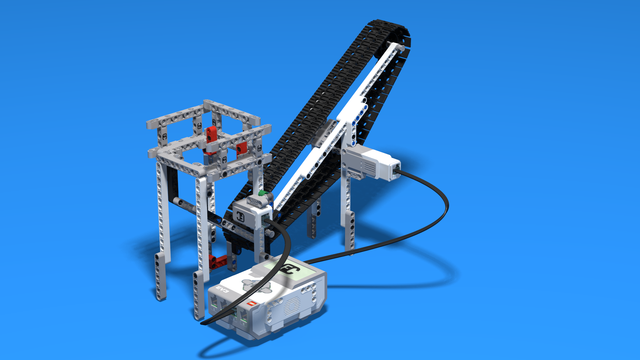This class is about constructing, but you have to keep the focus in the group. Note the following guidance on how to conduct the class.

To access the full video please subscribe to FLLCasts.com
- #1460
- 12 Sep 2019
In todays class we allow students to work on their building skill for most of the class time.
The programs could be just a simple block for moving unlimited for the motors. Be careful and pay attention that all students work on their tasks, but give them enough time to experiment.
Explain in advance that you do not expect from the students to complete all the tasks.
Courses and lessons with this Tutorial
This Tutorial is used in the following courses and lessons

Robotics with LEGO - Level 2.0 - Robots in Factories
The third level of the Robotics with LEGO curriculum for students from fifth to twelfth grades.
Robots in this level use two or three sensors at a time and students create more complex programs for them. The work of the differential and its usage in vehicles with one drive motor is explored. Robots interact with each other and transfer information or material between themselves. Students learn in depth how to create smoother line-following programs. In the end of the workday, robots leave the conveyor belt and relax with a recreational game of volleyball.
- 44
- 15:01
- 129

Lesson 6 - Conveyor Belt
In the next lesson we usually do a graduation. Write down your impressions about the students and the reasons why they have the grades you gave them.
- 5
- 4
- 10
- 3d_rotation 2

Level C2. "Cooperation". Robotics with LEGO
The sixth level of the Robotics with LEGO curriculum for students in third or fourth grade.
For the first time two different robots are required to solve a challenge. Students learn how to cooperate and find a common approach to the challenges and how to distribute their roles. Various robots are built, even a crane that loads a truck. Students use two sensors at the same time so that they find their target and find out whether their partner-robot is ready with their part of the challenge.
- 41
- 6:39
- 137

Lesson 6 - Conveyor belt
Introduction
Today you will have to come up with your own robot constructions by using the modules we give you. The robots should sort various types of plastics so that scientists can conduct their experiments.

Why do we want to accelerate waste degradation?
Many of the products we are using in our everyday lives are made of plastics or other non-degradable materials. Very often these things are used only once or twice and then thrown away to landfills where it takes them hundreds of years to degrade. A lot of living organisms die as a result of pollution. That is why today we are going to sort waste, resembled by balls of various colors, so that the waste is ready for testing.
An example of slow-degrading everyday products is plastic bags. It takes about 1000 years for a plastic bag to degrade. For comparison, it takes about a month or two for fallen leaves to degrade in autumn.
- 5
- 3
- 14
- 3d_rotation 2